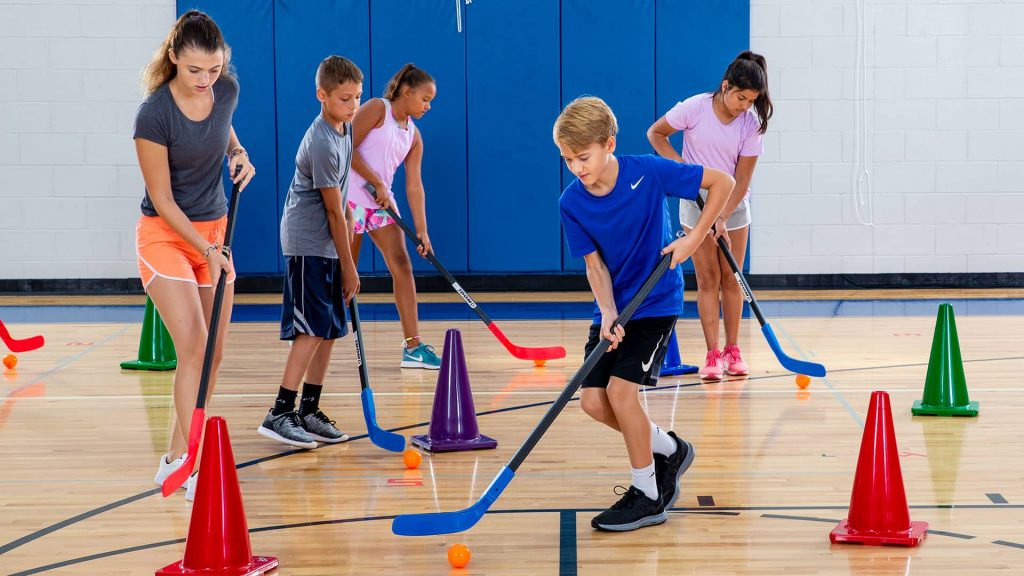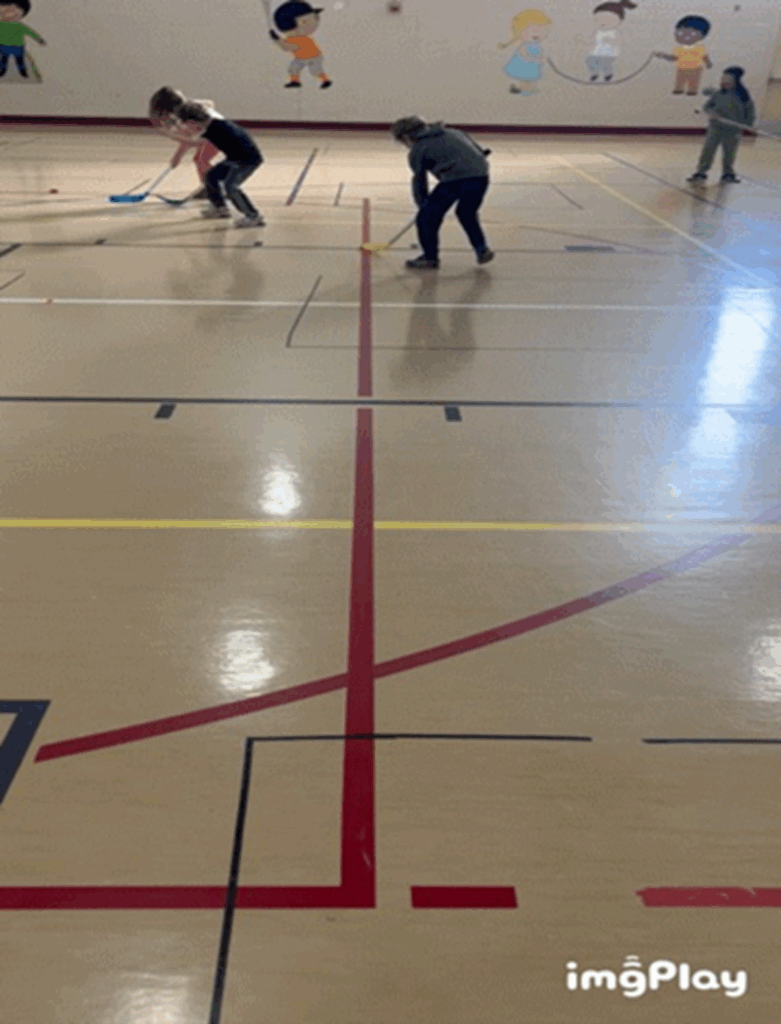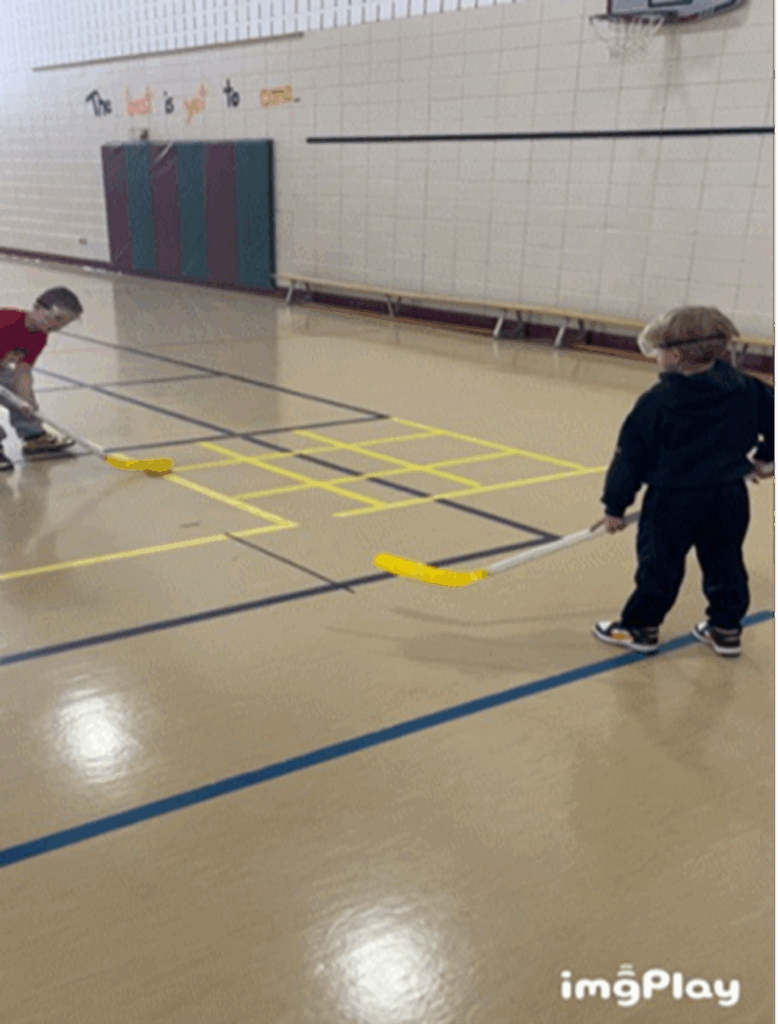Our third through fifth grade students are training for our annual floor hockey tournament. Students will have three practice sessions before the tournament begins. Students will choose their own position (goalie, defense, forward) during game play. This is a great community builder as families are invited to attend the tournament. Students make posters prior to the tournament cheering on their team.

History:
- Floor hockey originally evolved as an adaptation of ice hockey for play on the streets. Street hockey, which was played on pavement, used modified ice hockey equipment but this equipment did not hold up to street use.
- In 1963 a few sport equipment companies began developing plastic sticks and pucks that could be utilized both indoors and outdoors on smooth surfaces.
- The original floor hockey rules were adapted from National Hockey League rules.
- Floor hockey is easily taught because the skills are not very specialized and the rules are simple.
- Floor hockey became very popular and had many advantages.
- It provided physical fitness for all children and skills to enhance in later years.
- It was also made so that the game can be played safely and effectively, given it is taught the correct way.
- Floor hockey is relatively new but it provides an enjoyable medium for boys and girls to learn to play together on an “even skill” basis.
- Improvised equipment, along with numerous modified lead-up hockey type games has made floor hockey one of the fastest growing activities in the physical education program.
Emphasis and Progression:

- Many of the basic skills and simple playing strategies of hockey are introduced in levels.
- The main skills to practice are stick handling, passing, and shooting a puck.
- Students need to learn the basic rules of the game.
- The major portion of instruction should be devoted to activities and lead-up games.
Social Skills and Etiquette:
- Social skills should be emphasized in the game of floor hockey because the activity can become very competitive and rough if you don’t maintain the proper atmosphere.
- Discussions about good sportsmanship and teamwork are helpful in setting the proper tone for playing floor hockey.
- Students who are more aggressive in their play should be encouraged to involve teammates who are less assertive. This will enhance the self-concept of the less skilled student.
Objectives for floor hockey:
- To develop endurance, speed, agility, and strength.
- To develop the necessary techniques of team play.
- To develop a thorough understanding of the rules and regulations of the game.
- To develop a knowledge of the fundamentals of the game (floor hockey).
Rules:
- The object of the game is to hit the puck or ball into the opponent’s goal.
- We play 5-minute games with rests between each game. Teams will play a new team every 5 minutes.
- The game begins with a face-off at the centerline, and a face-off begins play after a goal is scored.
- Play should be continuous, and each play should be moving constantly throughout the game.
- In order for a player to be successful you must watch the puck or ball and not your opponent.
- Keep the sticks below the waist and avoid body contact with opponents.
Equipment:
- Floor hockey can be played on any area designed for basketball with a centerline for starting the game.
- Game equipment consists of a goal, plastic hockey sticks, and plastic pucks, or balls.
- The end of the goalie stick is wider and more square than on the other player sticks.
- The goal is an area 2 ft. by 6 ft. centered at the end of the playing area, and a goal box compasses 4 ft. by 6 ft. around the goal.
Positions:
- Goalie: this player stays within the goalie box and protects the goal from shots made by the opponent. When a save is made, the goalie then clears the puck or ball into offensive play.
- Center: this player moves the entire length of the playing field using offensive and defensive moves.
- Forwards: these players are offensive players staying on either side of the center, usually aid in passing to the center or, if possible, to score.
- Guards: these players are defensive players that prevent the opponents from scoring by hitting the puck or ball out of their area, usually by passing it to the center or forwards.
Guidelines:
- Players are allowed to use their feet to advance the puck or ball, but cannot score with their feet.
- Players can stop the puck or ball with their hands, but are not allowed to hold it.
- The puck or ball must precede offensive players across the center line.
Safety Awareness:
- Slashing/High Sticking – when a player keeps the opponent from hitting the puck or ball, or deliberately hitting the opponent above the waist.
- Pushing
- Blocking with the body
- Tripping or hooking with the stick
Hockey Keywords:
- Face-Off: The method of starting play; the dropping of the puck between the sticks of two opposing players.
- Stick Handling: Using alternating taps of both sides of the blade to move the puck or ball, also as dribbling.
- Passing: Moving the puck to a teammate.
- Shooting: Attempting to score a goal.
- Goalkeeper: A player who defends the goal, using their hands, feet, or stick to stop shots from going in the net.
- Defensemen: Players whose primary role is to defend their team’s goal and prevent opposing players from scoring.
- Forwards: Players who primarily focus on attacking the opponent’s goal and scoring goals.
- Penalties: Fouls that result in a player being temporarily removed from the game or receiving a penalty.
- Slashing: Intentionally or unintentionally hitting a player with the stick.
- High Stick: Swinging the stick higher than waist level.
- Hat Trick: When one player scores three goals in a game
Skills:
- Stick Handling: Players learn to control the puck with their stick while moving, dribbling, and maneuvering, enhancing coordination and agility.
- Passing and Receiving: Accuracy and timing are key to effective passing, which develops hand-eye coordination and communication.
- Shooting: Mastering various shots, including wrist shots and slap shots, builds accuracy, power, and reaction time.
- Defensive Skills: Players learn to block shots, intercept passes, and defend their net, developing quick reactions and anticipation.
- Physical Fitness: Floor hockey is a fast-paced sport, requiring continuous movement, quick changes in direction, and bursts of energy, improving cardiovascular health and endurance.
- Balance & Agility: The fast-paced nature of the sport requires players to maintain balance and agility while moving quickly and changing directions.
Hockey Activities for K-5 Students
Activity #1: Hockey Stick Handling Cues

- Grip = hands apart/thumbs down
- Look where you are going
- Keep puck close to stick
- 25 side to side movements
- Then start moving
Activity #2: Hockey Keep Away

- Place half the pucks away
- Goal is to keep your puck
- Practice changing directions
- Practice changing speeds
- Take a puck from someone else
Activity #3: Hockey Partner Passing Cues

- Grip = hands apart/thumbs down
- Look before you pass
- Keep the puck on the ground
- Passes to teammates stick Keep stick near the ground





